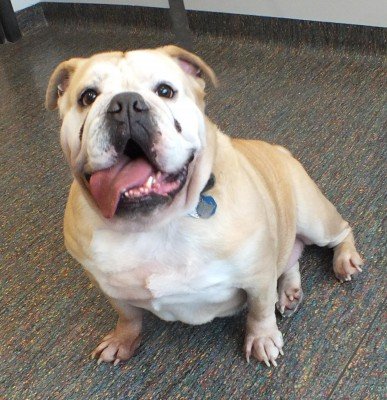National Pet Obesity Awareness Day sparks the question: Is your pet a healthy weight?

How much your pet is fed on a daily basis can be a perplexing question to answer as it depends on your pet’s breed, size and exercise routine. Oct. 12 is National Pet Obesity Awareness Day and a day of celebration for Kristie Bailey and Nala, her English Bulldog. Nala was obese when adopted from the Winnipeg Humane Society (WHS) and Bailey helped her seven-year-old dog lose over 20 pounds through proper diet and exercise.
Nala’s exercise plan has increased her life span and relieved pressure on her joints and spine. Obese pets are more likely to live shorter lives, have high blood pressure, and are more difficult to medically diagnose according to Dr. Erika Anseeuw, Director of Animal Health at the Winnipeg Humane Society.
“Maintaining your pet’s weight should be front of mind if you want your pet to live a happy and healthy life,” says Dr. Anseeuw. Pet owners should carefully read the feeding instructions on their pet’s food to avoid overfeeding, but Anseeuw believes one of the biggest culprits of pet obesity are high calorie treats.
Pet obesity is a common trend, with some numbers showing the majority of cats and dogs to be obese. In 2015, the Association for Pet Obesity Prevention estimated that 53.8% of dogs and 58.2% of cats in the USA were obese. Dr. Anseeuw sees a similar trend among animals at the WHS.
Bailey has experienced pet obesity prevention first-hand while helping her dog Nala lose the weight. When Nala weighed 73 pounds in February 2015 she couldn’t climb stairs, get into vehicles, or jump on the couch for cuddling without assistance from her family. In order to go to the bathroom, Nala needed to be physically carried outside.
Nala was kept on a strict diet and slowly introduced to an exercise plan. After being adopted, Nala visited the WHS every weekend for a few months to get indoor exercise. Now that Nala is a healthier weight, she explores outside with other canines at dog parks and enjoys going for walks with other dogs because it gives her a pace to maintain.
High calorie treats were not allowed in Nala’s diet until she started losing weight. Eventually Nala became more independent and has a better quality of life. She can jump in and out of vehicles, onto the couch to be with her family, and can now take herself outside for bathroom breaks.
“Nala is so loving, affectionate and such a character. We just want to keep her happy, healthy, and give her the best opportunity for a great life,” says Bailey.
Nala has come a long way since losing weight. She’s now an expert ball fetcher, and loves taking part in a good ol’ Canadian tradition: Hockey. The videos below are some early clips of Nala before she lost her weight.

